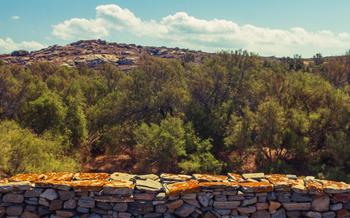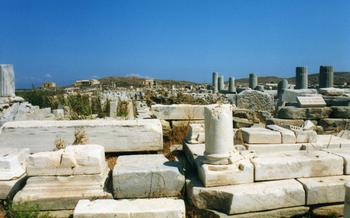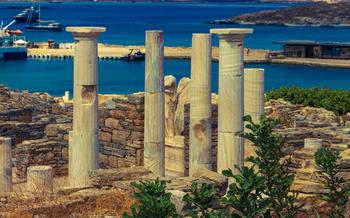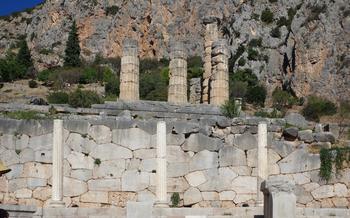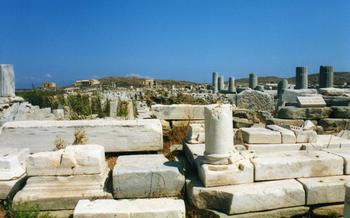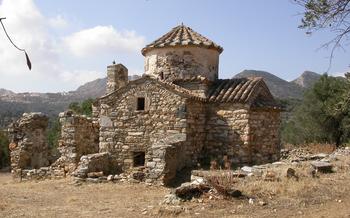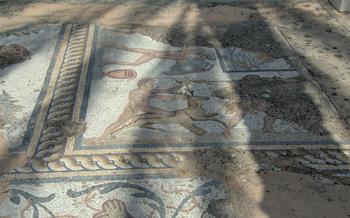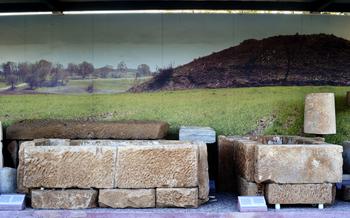
The Sanctuary of Klopedi
- The Sanctuary of Klopedi: A Historical Overview
- Location and Getting There
- Exploring the Sanctuary
- The Temple of Apollo
- The Altar of Zeus
- Other Structures and Artifacts
- Religious Significance
- Historical Context
- Excavations and Discoveries
- Preservation and Conservation
- Visiting Information
- Local Culture and Customs
- Nearby Attractions
- Insider Tip: Unveiling Hidden Treasures and Creating Lasting Memories
The Sanctuary of Klopedi: A Historical Overview
The Sanctuary of Klopedi stands as a testament to the rich religious and cultural heritage of ancient Greece. Located on the scenic island of Lesbos, the sanctuary dates back to the 7th century BC, making it one of the oldest and most significant religious sites in the Aegean region.
Dedicated to the worship of Apollo, the sanctuary served as a pilgrimage site for devotees from across the ancient world. Archaeological excavations have unearthed a wealth of artifacts, shedding light on the sanctuary's history, religious practices, and cultural significance. Discoveries include remnants of temples, altars, and votive offerings, providing valuable insights into the beliefs and rituals of the ancient Greeks.
The sanctuary's strategic location on the slopes of Mount Olympos further enhanced its importance. The mountain was considered sacred in ancient Greek mythology, associated with the gods and goddesses of Mount Olympus. The sanctuary's proximity to this sacred site likely contributed to its status as a prominent religious center in the region.
Location and Getting There
The Sanctuary of Klopedi is situated on the picturesque island of Lesbos, also known as Mytilene, which belongs to the North Aegean region of Greece. The sanctuary is found in the southeast portion of the island, 7 kilometers away from the city of Mytilene, the island's capital. Visitors can easily reach the sanctuary by embarking on a scenic drive, which offers breathtaking views of the surrounding countryside and the glistening Aegean Sea.
For those arriving by air, Mytilene International Airport (MJT) provides convenient connectivity to the island. After landing, you can rent a car, hire a taxi, or catch a public bus to take you to the Sanctuary of Klopedi. The sanctuary's proximity to other attractions on the island makes it an ideal destination for travelers seeking a comprehensive exploration of Lesbos' rich heritage.
Exploring the Sanctuary
The Sanctuary of Klopedi is a fascinating and sprawling site, offering visitors a glimpse into the religious and cultural practices of ancient Greece. As you explore the sanctuary, you'll encounter various structures and remains that speak to its rich history and significance.
The layout of the sanctuary is quite organized, with a central courtyard surrounded by temples, altars, and other structures. The most prominent feature is the Temple of Apollo, which stands at the far end of the courtyard. Other notable structures include the Altar of Zeus, located near the entrance, and several smaller temples and shrines dedicated to various deities.
As you wander through the sanctuary, you'll notice the impressive architectural features that have survived the test of time. The temples and altars are adorned with intricate carvings and sculptures, depicting scenes from mythology and religious rituals. The remains of these structures provide valuable insights into the artistry and craftsmanship of the ancient Greeks.
The sanctuary's location is also significant, as it sits atop a hill overlooking the sea. This strategic position not only offered protection from potential invaders but also provided a stunning view of the surrounding landscape. The sanctuary's natural setting added to its sacredness and made it a popular destination for pilgrims and worshippers from across the region.
The Temple of Apollo
The Temple of Apollo is one of the most prominent structures within the Sanctuary of Klopedi. Dedicated to the Greek god Apollo, the temple holds immense historical and religious significance. Built in the 6th century BC, the temple showcases the architectural prowess of the ancient Greeks.
Constructed using local limestone, the temple exhibits a Doric architectural style, characterized by its simplicity, strength, and harmony. Its rectangular shape and sturdy columns create an imposing presence, while the intricate carvings and decorative elements add a touch of elegance. The temple's well-preserved remains, including portions of its walls, columns, and pediments, provide valuable insights into ancient Greek construction techniques and artistic sensibilities.
The Temple of Apollo served as a central place of worship for the people of Mytilene and the surrounding region. Here, they paid homage to Apollo, the god of music, poetry, healing, and prophecy. Devotees would offer sacrifices, prayers, and libations, seeking Apollo's favor and guidance. The temple was also a site for religious festivals and ceremonies, where the community would come together to celebrate and honor the deity.
The temple's location within the sanctuary is particularly noteworthy. Situated on a hilltop overlooking the city of Mytilene and the Aegean Sea, the temple commands a breathtaking view. This strategic placement not only enhanced the temple's visibility but also symbolized its importance as a sacred and revered site.
The Altar of Zeus
The Altar of Zeus, a prominent structure within the Sanctuary of Klopedi, holds significant historical and religious importance. Constructed in honor of the almighty Zeus, the king of the gods in Greek mythology, the altar served as a sacred site for rituals, ceremonies, and offerings.
The altar's imposing presence and intricate design reflect the reverence bestowed upon Zeus. Its well-preserved remains showcase the architectural prowess of ancient Greek builders. The altar's elevated position within the sanctuary further emphasizes its significance as a focal point for religious practices.
Rituals and ceremonies held at the Altar of Zeus were integral to the religious life of the ancient Greeks. Devotees would gather around the altar to offer sacrifices, prayers, and libations to the mighty god. These offerings were believed to appease Zeus, ensuring his favor and protection.
The cultural and religious importance of the Altar of Zeus extended beyond the sanctuary's boundaries. It served as a symbol of Zeus's omnipotence and was revered throughout the ancient Greek world. The altar's enduring legacy continues to inspire awe and reverence among visitors who seek to connect with the spiritual essence of this sacred site.
Other Structures and Artifacts
In addition to the Temple of Apollo and the Altar of Zeus, the Sanctuary of Klopedi boasts several other notable structures and artifacts that offer valuable insights into its history and significance. Among these are:
-
Treasury Buildings: The sanctuary housed several treasury buildings used to store valuable offerings and donations made by devotees and pilgrims. These buildings were often decorated with intricate carvings and inscriptions, providing glimpses into the wealth and devotion of the ancient Greeks.
-
Stoa: A stoa, or covered walkway, lined the eastern side of the sanctuary. It served as a sheltered space where visitors could congregate, seek refuge from the elements, or engage in discussions and rituals. The stoa's columns and entablature often featured elaborate ornamentation, adding to the sanctuary's overall grandeur.
-
Altars and Votive Offerings: Numerous altars of various sizes and shapes can be found throughout the sanctuary, each dedicated to a specific deity or purpose. These altars were used for offerings and sacrifices, and many are adorned with intricate carvings or inscriptions that provide insights into the religious practices of the ancient Greeks. Votive offerings, such as pottery, jewelry, and statuettes, have also been discovered, offering a glimpse into the personal devotion and gratitude of the sanctuary's visitors.
-
Residential Buildings: The sanctuary also included residential buildings where priests, priestesses, and other officials lived and worked. These buildings often contained rooms for sleeping, cooking, and storage, as well as spaces for conducting religious rituals and ceremonies. The discovery of these residential structures sheds light on the daily lives of those who served the sanctuary and maintained its sacred traditions.
Religious Significance
The Sanctuary of Klopedi held immense religious significance as a sacred center of worship in ancient Greece. Dedicated to the revered deities Apollo and Zeus, it served as a place of pilgrimage and devotion for the people of Mytilene and beyond. Rituals, ceremonies, and festivals were held within the sanctuary's hallowed grounds, creating a spiritual atmosphere that drew worshippers from across the region. The sanctuary's location, nestled amidst serene natural surroundings, further enhanced its sacred aura, fostering a deep connection between the divine and the mortal realm.
The sanctuary's religious importance extended beyond its local significance. It was closely associated with other major religious sites in Greece, forming part of a broader network of sacred places. This interconnectedness highlights the sanctuary's role in ancient Greek religion, as it contributed to the rich tapestry of beliefs and practices that shaped the spiritual landscape of the Hellenic world.
Historical Context
The Sanctuary of Klopedi flourished during the Hellenistic period, which spanned from the 4th to the 1st century BC. This era was characterized by significant political and cultural changes in Greece, following the conquests of Alexander the Great. Mytilene, the capital of Lesbos, was a prominent city-state during this time, and the sanctuary played an important role in the religious and cultural life of the island.
The sanctuary's location on a hilltop overlooking the sea made it a strategic and symbolic site. It served as a religious center for the people of Mytilene and the surrounding region. The worship of Apollo and Zeus, two of the most important gods in the Greek pantheon, reflects the sanctuary's significance in the religious landscape of the Hellenistic world.
The sanctuary's prosperity during this period is evident in the construction of impressive temples, altars, and other structures. Archaeological evidence suggests that the sanctuary was a place of pilgrimage and devotion, attracting visitors from across the Aegean region. It also served as a center for religious festivals and ceremonies, which played an essential role in the social and cultural life of the community.
Understanding the historical context of the Sanctuary of Klopedi allows us to appreciate its importance in the broader context of ancient Greek civilization. It offers a glimpse into the religious beliefs, practices, and cultural traditions of the Hellenistic period, and sheds light on the role of sanctuaries in shaping the social and cultural fabric of ancient Greek society.
Excavations and Discoveries
The Sanctuary of Klopedi has been the subject of extensive archaeological excavations since the late 19th century. These excavations have unearthed a wealth of artifacts and structures that have shed light on the history and significance of the sanctuary.
One of the most significant discoveries was the remains of the Temple of Apollo, which was the centerpiece of the sanctuary. The temple was built in the 6th century BC and featured a grand facade with intricate carvings and sculptures. Other notable discoveries include the Altar of Zeus, which was used for animal sacrifices, and a number of smaller shrines and altars dedicated to various deities.
The excavations have also yielded a large number of artifacts, including pottery, coins, jewelry, and inscriptions. These artifacts have provided valuable insights into the daily life and religious practices of the ancient Greeks who frequented the sanctuary.
Ongoing research and excavations at the Sanctuary of Klopedi continue to reveal new information about this important religious site. Future discoveries are likely to shed even more light on the history and significance of the sanctuary, and to provide a deeper understanding of ancient Greek religion and culture.
Preservation and Conservation
Preserving and conserving the Sanctuary of Klopedi is of utmost importance to safeguard its historical and cultural significance. The sanctuary's remains have withstood the test of time, but they are vulnerable to deterioration and damage due to natural elements, human activity, and the passage of time.
Efforts to protect and conserve the site are ongoing, involving collaboration between archaeologists, conservators, and local authorities. These efforts include:
-
Regular maintenance and upkeep: The sanctuary's structures, artifacts, and surrounding landscape are regularly inspected and maintained to prevent further deterioration.
-
Restoration and conservation projects: When necessary, restoration projects are undertaken to repair damaged structures, stabilize foundations, and conserve artifacts. These projects are carried out using traditional techniques and materials to ensure authenticity and integrity.
-
Environmental protection: The sanctuary's natural surroundings are protected to minimize the impact of erosion, vegetation growth, and pollution. Sustainable practices are employed to manage the site's ecology and preserve its natural beauty.
-
Visitor management: Controlled access to the sanctuary helps to reduce wear and tear on the site. Visitors are encouraged to follow designated paths, refrain from touching or climbing on structures, and respect the sanctuary's cultural and historical significance.
By preserving and conserving the Sanctuary of Klopedi, we ensure that future generations can continue to appreciate and learn from this remarkable archaeological treasure. Visitors are encouraged to be responsible tourists and contribute to the preservation efforts by following guidelines, respecting the site, and supporting conservation initiatives.
Visiting Information
Opening Hours and Admission Fees:
The Sanctuary of Klopedi is generally open to the public during daylight hours. Opening hours may vary depending on the season and weather conditions. There is a small admission fee for entry to the sanctuary, which helps to support the ongoing preservation and conservation efforts.
Guided Tours and Tour Options:
Guided tours of the sanctuary are available for visitors who wish to learn more about its history, significance, and archaeological discoveries. These tours can be arranged through local tour operators or by contacting the Mytilene Archaeological Museum. Visitors can also choose to explore the sanctuary independently, using guidebooks or information panels on-site.
Facilities and Amenities:
The sanctuary is equipped with basic facilities for visitors, including restrooms and parking areas. There are no restaurants or cafes within the sanctuary itself, but visitors can find a variety of dining options in the nearby town of Mytilene.
Tips for Planning a Visit:
- Check the weather forecast before visiting, as the sanctuary is mostly exposed and can be hot and sunny during the summer months.
- Wear comfortable shoes, as the sanctuary involves some walking on uneven terrain.
- Bring water and snacks, as there are no food or drink vendors within the sanctuary.
- Be respectful of the site's historical and cultural significance, and avoid touching or climbing on any of the structures or artifacts.
- Consider visiting the Mytilene Archaeological Museum before or after your visit to the sanctuary to learn more about the history and discoveries of the site.
Local Culture and Customs
Mytilene and Lesbos are steeped in rich cultural traditions and customs that reflect the island's unique heritage. Visitors to the sanctuary will have the opportunity to immerse themselves in the local culture and experience the warmth and hospitality of the Greek people.
The island's cuisine is a culinary delight, blending traditional Greek flavors with local ingredients. Must-try dishes include fresh seafood, olive oil-based dishes, and the famous Mytilene cheese. Visitors can savor these delicacies at local tavernas and restaurants, enjoying the vibrant atmosphere and friendly service.
Mytilene and Lesbos are also known for their vibrant festivals and events. The annual Sardine Festival, held in August, is a highlight, attracting visitors from all over the world. The festival celebrates the island's fishing heritage with music, dancing, and, of course, plenty of sardines.
To fully embrace the local culture, visitors are encouraged to interact with the local community respectfully. Learning a few Greek phrases, showing interest in local customs, and supporting local businesses are all ways to show appreciation for the island's heritage.
Nearby Attractions
Enrich your experience in Mytilene and Lesbos by exploring the wealth of nearby attractions. Delve into the ancient history of the region at the Mytilene Archaeological Museum, showcasing artifacts from the sanctuary and other significant sites.
For a taste of natural beauty, embark on a scenic boat trip to the picturesque Molyvos, a charming village nestled amidst olive groves and turquoise waters. Discover the awe-inspiring petrified forest of Lesvos, a unique geological phenomenon that transports you back in time.
Immerse yourself in local culture at the Ouzo Museum, celebrating the island's famous anise-flavored spirit, or savor the flavors of Lesvos at a traditional taverna, indulging in mouthwatering seafood and regional specialties.
Create unforgettable memories by combining a visit to the Sanctuary of Klopedi with these diverse attractions, crafting a comprehensive travel experience that unveils the rich tapestry of Mytilene and Lesbos.
Insider Tip: Unveiling Hidden Treasures and Creating Lasting Memories
Beyond the well-trodden paths of the Sanctuary of Klopedi, there lies a hidden gem waiting to be discovered. Tucked away in a secluded corner of the sanctuary, visitors can stumble upon an ancient well, its timeworn stones whispering tales of a bygone era. Legend has it that this well possesses mystical properties, granting wishes to those who toss a coin into its depths. Whether or not one believes in such tales, the well offers a moment of tranquility and reflection, a chance to connect with the spirits of the past.
For those seeking a unique experience, a visit to the sanctuary during the annual "Feast of Apollo" is a must. Held every summer, this vibrant festival brings the ancient world to life with traditional music, dancing, and reenactments of ancient rituals. Participants don period costumes, transforming the sanctuary into a living tableau of history. It's an opportunity to immerse oneself in the culture and customs of ancient Greece, creating memories that will last a lifetime.
Photography enthusiasts will delight in capturing the sanctuary's beauty through their lenses. The golden light of dawn casts a magical glow on the ruins, while the setting sun paints the sky with hues of orange and purple, creating a breathtaking backdrop for capturing stunning images. Remember to bring a tripod to stabilize your camera and capture the essence of this sacred place.
As you explore the sanctuary, keep an eye out for the intricate carvings and inscriptions adorning the stones. These hidden details offer glimpses into the lives and beliefs of the ancient Greeks, revealing their reverence for the gods and the significance of this sacred site. Take your time to admire these artistic treasures, as they hold the power to transport you back in time and connect you with the spirit of ancient Greece.
